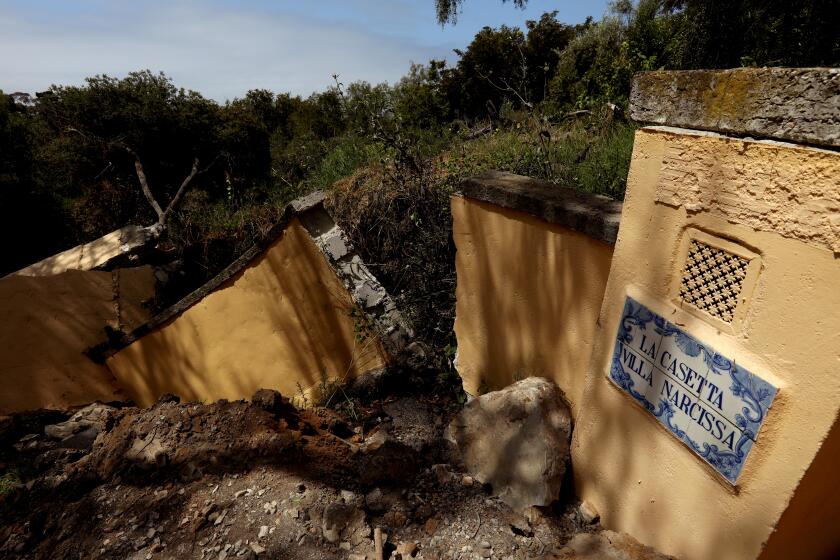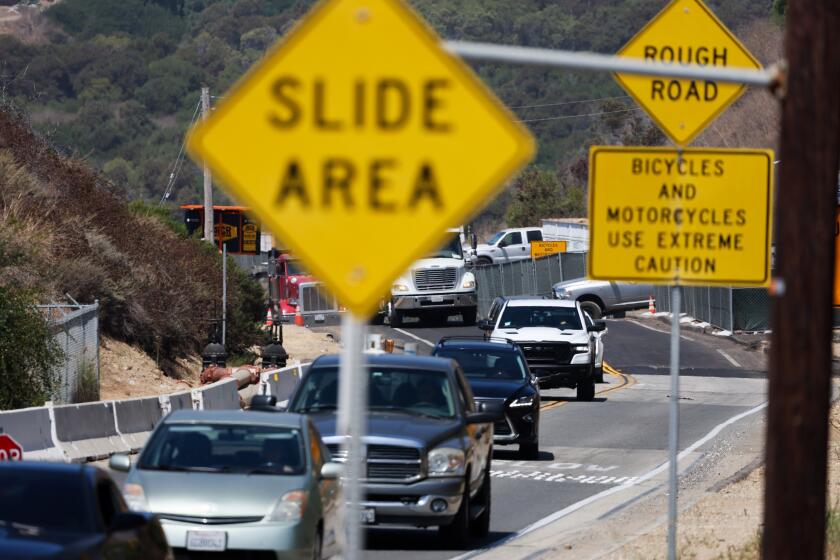Some help is finally set for residents in Palos Verdes’ landslide crisis. They hope it’s not too late

- Share via
After weeks of residents begging for outside help with landslide damage in the Palos Verdes Peninsula, some assistance is finally on the way.
The Rancho Palos Verdes City Council on Tuesday allocated $2.8 million — more than half of a $5-million grant from Los Angeles County — for direct relief to residents in the Portuguese Bend area facing landslide damage or a loss of vital utilities — or in many cases, both.
“These emergency grants will deliver long-overdue immediate assistance to those whose lives have been upended by land movement and utility shutoffs, helping them cover essential costs like home repairs and temporary housing,” Mayor John Cruikshank said in a statement.
The city will distribute up to $10,000 to families most directly affected by the land movement and the shutoffs, estimated to be about 280 homes in Rancho Palos Verdes. Many residents, though, have said they are facing costs closer to $100,000 from the last few weeks’ events, which left them scrambling to fortify homes’ foundations, switch to off-grid solar energy and convert natural gas lines to propane.
“These residents are going through hell and, up until now, they have shouldered the financial burden of this landslide entirely on their own,” Los Angeles County Supervisor Janice Hahn said in a statement. “$10,000 may not be enough to cover the costs of what these homeowners are facing, but I think it is important to get them this help.”
The funds are not extended to residents in Rolling Hills, the nearby city where about 50 residents also recently lost power and gas service because of land movement in a few neighborhoods, which sit just up the hill from the Portuguese Bend landslides.
Living inside the Rancho Palos Verdes landslide zone: Darkness, propane, batteries and determination
Patty Perkinson is not ready to give up on her Rancho Palos Verdes home — despite the active landslide causing untold damage and now the loss of vital utilities.
City officials on Tuesday were grateful for Hahn’s support, noting that other emergency resources — such as state or federal funding — have been almost impossible to secure, even as the landslide disaster has escalated.
“The county of Los Angeles is the only [one] that has helped us at all,” Councilmember David Bradley said Tuesday night. “The city cannot continue to fund everything because we will be broke.”
Although Gov. Gavin Newsom declared a state of emergency in the landslide area after utilities were cut, officials with the California Governor’s Office of Emergency Services have told city officials the area would not qualify for state or federal disaster reimbursement because they are facing a preexisting landslide, according to the city’s latest landslide report.
The area has long been known for land movement — with waves of increased shifting occurring ever since the ancient landslide area became reactivated in 1956 by construction work nearby — but experts have called the faster and more expansive movement over the last few months unprecedented for several different reasons.
In the absence of outside help, city officials are trying to find ways to respond to the growing emergency despite mounting expenses — ideally, before the rainy season. Rain and runoff are known to exacerbate and accelerate the land movement, as groundwater drives the geologic shifting.
“We just need to stop the darn thing from moving,” Cruikshank said. “This is a nightmare.”
Officials still know little about the extent of the Portuguese Bend land movement on the Palos Verdes Peninsula, leaving residents in a torturous limbo.
City staff outlined about $26 million worth of projects that were recommended to try to mitigate land movement, including efforts to keep water from entering the ground by filling fissures and improving drainage, as well as projects to remove groundwater by installing additional deep wells and pumps. The city typically operates on a yearly budget of less than $40 million.
After hours of deliberation, city leaders approved $14 million for landslide emergency response and mitigation, while making plans to revisit the projects soon if more money is necessary.
Dozens of residents testified at the City Council meeting, some expressing concern about unnecessary red tape that could limit access to the $10,000 grants, but most simply urging support for immediate winterization efforts and more groundwater pumping in light of the upcoming rainy season.
“I implore the council to both put in deep wells ... [and] proceed with the winterization for Altamira canyon,” said Gordon Leon, who chairs one of the local landslide abatement districts. “The impact of water coming into the several major fissures that are in the upper Altamira canyon will be devastating when we see millions of gallons of [rain] water.”
Accelerating landslides in Rancho Palos Verdes have continued to upend life. But residents like Gordon Leon aren’t ready to give up.
In recent weeks, the city has drilled six new, deep dewatering wells, which have been pumping out 600 gallons of water a minute, said Ara Mihranian, Rancho Palos Verdes city manager. Initial measurements have shown that the pumping appears to have helped slow the land movement.
“I feel like we’re turning a page here,” Mihranian said.
Mike Phipps, the city’s contracted geologist, said that overall movement had started to naturally decelerate in August for the first time in months, probably because there hadn’t been rain in the last five months. But in September, after the activation of the new dewatering wells, several areas showed a more dramatic decrease in movement, which he called “incredible news.”
“It’s a direct impact from the dewatering well activity,” Phipps said.
In August, the almost 700 acres of landslide area moved about 8 inches a week on average, still a disastrous amount but down from prior months, Phipps’ latest report found. The most active spots were shifting about 11 inches per week, though that measurement was down from a high of about 13 inches a week this spring.
Officials are hoping that slower movement could allow utility companies, which have pulled out indefinitely from about 300 homes, to come back to the area. In the meantime, both city and county leaders have called on Southern California Edison and Southern California Gas to provide more support for residents who abruptly lost utilities, most without any compensation or backup plan.
“These utility companies are monopolies,” Hahn wrote this week in a letter to the California Public Utilities Commission. “They have profited off these residents for decades as the chosen utility providers for this region. Given that, these utilities should be responsible for providing alternative sources of power to their customers on the Palos Verdes Peninsula when they choose to shut off service.”
Though many residents have been dealing with the fallout of the utility shutoffs for more than a month — many already paying out of pocket for off-grid solutions — Hahn urged the commission to hold the utilities accountable.
Southern California Edison and Southern California Gas both contributed $50,000 to a landslide relief fund started by the Palos Verdes Rotary Club. No funds have yet been distributed, however, and Rotary officials this week said they do not yet have a plan for doing so.
After several days of power shutoffs in Rancho Palos Verdes Communities affected by accelerated land movement, Gov. Gavin Newsom declares a state of emergency
Hahn called those amounts insufficient, given the hundreds of homes now without power and gas.
“More robust financial assistance programs are needed to support displaced residents and those suffering from indefinite service outages,” Hahn wrote in the letter.
Hahn and Rancho Palos Verdes officials plan to meet with the Public Utilities Commission next week.
Gabriela Ornelas, a spokesperson with Southern California Edison, said the utility is aligned with the goal of restoring power to those affected by the land movement, “provided it can be done safely.” She didn’t directly respond to Hahn’s calls for more assistance for residents but called the situation “constantly evolving.”
A spokesperson for Southern California Gas didn’t respond to a request for comment.
“It still is 100% their responsibility to provide power and gas. … If they lose money doing it, tough break,” said Cruikshank, who will be at the meeting. “We’re going to continue to push that. ... Our residents need to be whole.”
More to Read
Sign up for Essential California
The most important California stories and recommendations in your inbox every morning.
You may occasionally receive promotional content from the Los Angeles Times.















